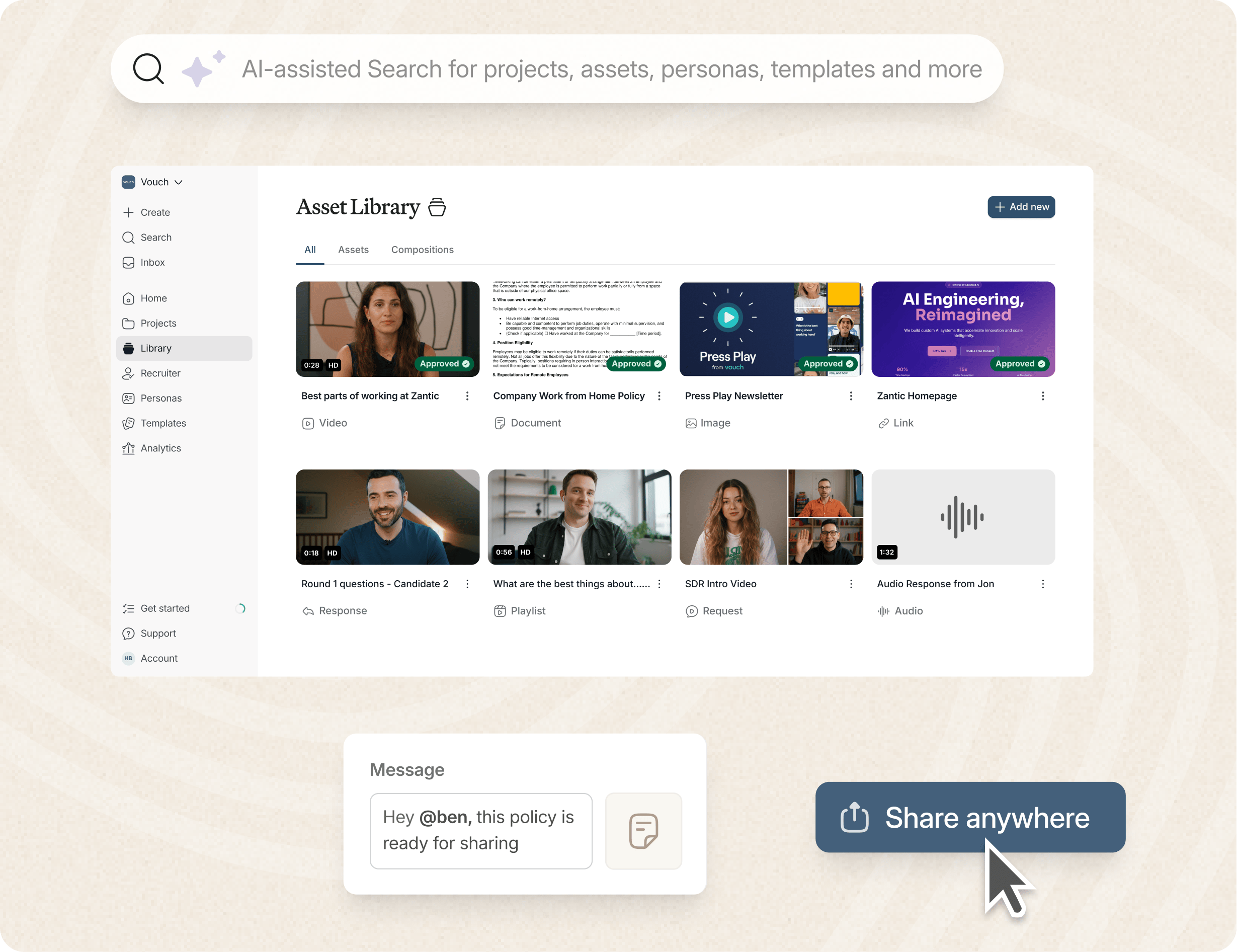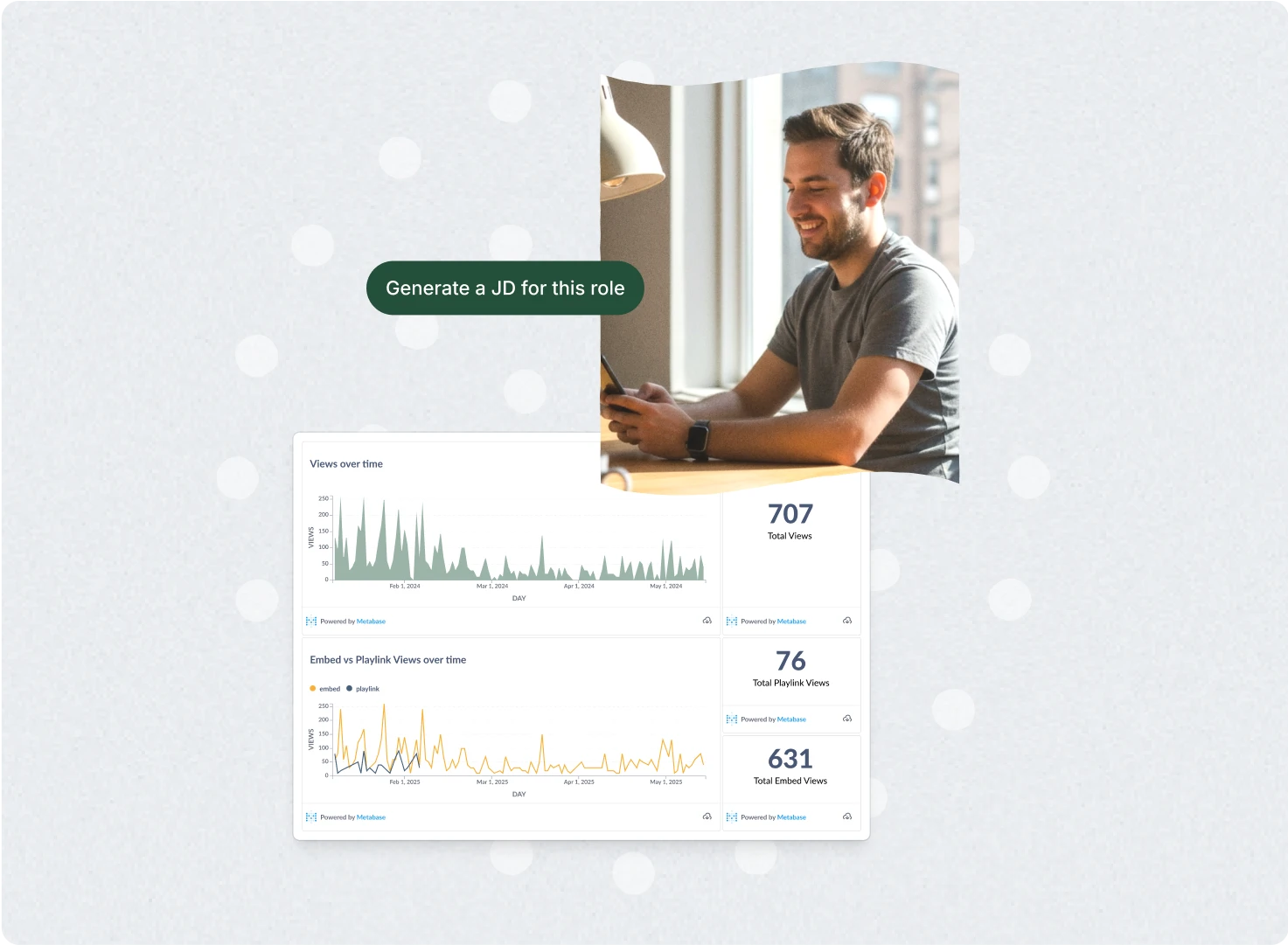Did you know that approximately 95% of businesses agree that assessing the quality of hire is critical, yet only 33% track it effectively?
Yet, recruiting metrics are crucial when it comes to making informed hiring decisions.
These metrics are also crucial to optimizing your hiring process and reducing your costs per hire.
This guide will explore the 7 most important recruitment metrics you should be tracking in 2026. These metrics will help you improve your hiring strategy and attract the best talent for your organization.
Let's dive in.
Key Takeaways
- Tracking the right metrics helps you make data-driven hiring decisions.
- They enable you to manage your recruitment budget more effectively.
- Tools like Vouch help streamline your hiring process while providing a better candidate experience.
What Are Recruiting Metrics?
Recruiting metrics, also known as hiring metrics or staffing metrics, are a set of measurements or data points used to evaluate the success of the recruiting process and the quality of your employee talent.
These metrics help you analyze your recruiting efforts, optimize your strategies, and ensure you hire the right candidates for your organization and, importantly, your culture.
The goal is to make hiring more cost-effective and ensure quality candidates come through your recruitment funnel.
Important metrics include average time to fill, time to hire, source of hire, diversity recruiting, attrition rate, quality of hire, applicants per opening, and cost per hire.
Each metric serves a unique purpose in your recruitment process - and you can optimise every step.
The average cost to hire an employee in the United States was around USD 4,129, based on data from the Society for Human Resource Management.
The AI-enabled workspace for talent teams.
- Unified workspace for talent teams
- Accelerate hiring with AI tools
- Auto-generate polished hiring and employer brand content
- Easily repurpose assets across all channel

Using Recruiting Metrics To Hire Top Talent
Recruiting metrics are there to help you make more informed hiring decisions, which leads to optimizing your talent acquisition results.
By tracking and analyzing these metrics, you can find opportunities in the data that you simply can't pick up with "your gut."
While instinct is vital in HR and hiring, the data is still needed to analyze and confirm your instincts.
One key benefit of tracking recruiting metrics is reporting to upper management and ensuring your hiring decisions align with your company's growth goals and KPIs.
In addition, tracking your recruiting metrics helps to reduce recruitment costs and enhance the candidate experience. By identifying bottlenecks, for example, you can streamline operations and attract top talent more efficiently, making your organization more attractive and helping grow your Employer Brand.
Let's jump into the 7 vital recruitment metrics you need:
Recruitment Metrics 1: Time to Fill
Time to fill is a crucial recruitment metrics that measures the efficiency of your hiring process.
It refers to the time it takes to source and hire a new candidate for an open position within your organization.
By tracking this metric, you can quickly see the effectiveness of your recruitment process and identify areas for streamlining your hiring.
Reducing time to fill is essential for hiring efficiency. It allows you to fill open roles quickly and ensure minimal disruption to your operations.
A lengthy filling time can lead to increased costs, missed business opportunities, and even employee burnout due to increased workload.
By tracking time to fill, you can set benchmarks, identify bottlenecks in your recruitment process, and implement strategies to speed up the hiring timeline.
On average, it takes 36 days to fill a position, according to research by SHRM.
What Are The Benefits Of Measuring Time To Fill?
- Identify areas for improvement: By tracking time to fill, you can pinpoint specific stages of the recruitment process that may be causing delays. This could include lengthy screening processes, slow candidate feedback, or inefficient interview scheduling.
- Optimize your recruitment process: Armed with data on time to fill, you can make data-driven decisions to streamline your recruitment process. This may involve automating specific steps, leveraging technology for candidate screening, or improving communication and collaboration among hiring team members.
- Enhance candidate experience: A lengthy hiring process can deter top candidates and result in a negative candidate experience. By reducing time to fill, you can provide a more streamlined and efficient experience for candidates, increasing the likelihood of attracting and securing top talent.
Measuring time to fill is essential for optimizing your hiring process and ensuring recruitment efficiency.
Why Streamline Your Hiring Process Further?
In recruitment metrics, time is of the essence.
The longer it takes to hire a candidate, the more likely they are to accept an offer from another company - especially top talent, who often have the pick of companies.
Streamlining their hiring process can help you attract and onboard top talent more quickly.
Time to hire measures the speed at which candidates move through the hiring process, from when they apply or are approached to when they accept the job. By monitoring this metric, you can identify any bottlenecks or delays in your recruitment process and take steps to address them.
This could include streamlining your application and interview processes with modern tools like Vouch video, providing timely candidate feedback, or improving communication between hiring managers and recruiters.
What Are The Benefits of Streamlining Time to Hire?
- Attract top talent: In today's competitive job market, candidates have more options than ever. By streamlining your hiring process, you can ensure you don't lose out on qualified candidates who receive offers from competitors.
- Improve candidate experience: A lengthy hiring process can be frustrating for candidates. By reducing the time to hire, you can provide a more positive experience and increase the likelihood of candidates accepting your job offers.
- Increase hiring speed: An efficient hiring process can fill vacancies faster, reducing the impact of unfilled positions on productivity and team morale.
- Save recruitment costs: A prolonged hiring process can be costly in terms of advertising, interviewing, and administrative expenses. By streamlining the hiring time, you can optimize your recruitment budget and allocate resources more effectively.
If you would like to read more about streamlining your hiring journey, please see here.
Research found that companies with a streamlined, more positive candidate experience improve their quality of hire metrics by up to 70%.
Recruitment Metrics 2: Source of Hire
When recruiting top talent, effectively utilizing recruitment channels and recruitment enablement strategies are crucial.
Tracking the source of hire metric, offer acceptance, and application completion rates allows you to identify which job postings generate the most qualified candidates and yield the highest return on investment (ROI) for your recruitment marketing efforts.
By analyzing the total number of applicants, the number of days it takes to fill a position and external recruiting costs, you can optimize your application process and improve overall efficiency.
This could be using traditional job boards, PPC, or social media for recruitment.
By analyzing the source of hire data, you can make data-driven decisions to optimize your recruitment strategy.
For example, if you find that your company's careers page is a major source of hire and that traffic from a LinkedIn Video provides the highest quality candidates.
If you find that certain channels consistently yield higher-quality hires, it may indicate that your brand messaging and employer value proposition resonate well with candidates on those platforms. Then, you can focus on doing more of that.
This insight allows you to refine your messaging and further strengthen your employer brand in the channels driving the best results and ROI.
Recruitment Metrics 3: Diversity and Inclusion
Diversity recruiting is crucial these days; striving to create a diverse and inclusive workplace culture is one of the major motivators for the world's best companies.
Tracking diversity recruitment metrics ensures that your candidate pipeline represents various backgrounds, experiences, and perspectives. This promotes fairness and equity and brings unique insights and ideas to your organization.
One important metric to monitor is the diversity of candidates in your overall talent pool, which includes your social media followers.
Important metrics include gender, ethnicity, age, and other demographics. By collecting this data, you can identify any imbalances or biases that may exist in your hiring process and take steps to address them.
For example, you may discover that certain demographics are underrepresented in your applicant pool, prompting you to explore new sourcing channels or revise your job descriptions to attract a more diverse range of candidates.
Furthermore, by accessing this data, you may also notice that your ideal candidate persona is missing and may need to update your Employer Branding and Employee Value Propositions to fix.
What Are Diversity Recruitment Best Practices?
Tracking diversity recruiting metrics helps you create a more inclusive workforce and aligns with the growing expectations of employees and customers.
Companies prioritizing diversity and inclusion often enjoy higher employee satisfaction, increased innovation, and improved business performance.
- Implement bias training for hiring managers to ensure fair and inclusive evaluations of candidates.
- Establish partnerships with organizations focusing on diversity and inclusion to expand your candidate pool.
- Create an inclusive company culture that values and supports diversity at all levels.
- Regularly review and update your diversity recruiting strategies to stay current with evolving best practices.
A 2021 report from McKinsey revealed that companies in the top quartile for ethnic and cultural diversity in executive teams are 36% more likely to experience above-average profitability.
Recruitment Metrics 4: Attrition Rate
Employee retention is a critical aspect of building a successful organization.
High attrition rates can hurt productivity, morale, and overall performance, leading to increased average costs and unmet hiring goals. Tracking the attrition rate for a specific period is essential for assessing employee retention and informing hiring efforts to reduce turnover.
By understanding these metrics, you can improve the conversion rate of the best candidates for each job position and implement effective strategies to retain top talent.
An attrition rate is a recruitment metric that measures the percentage of employees who leave an organization within a specific time period, typically 1-3 years. It provides valuable insights into the effectiveness of the recruitment process, the employee experience, and potential areas for improvement.
By analyzing this metric, you can identify trends, patterns, and factors contributing to turnover.
In our experience, a big part of high attrition rates is often failing to work on your Employer Brand. We've written this article on Employer Brand if you feel like yours could use some work.
To calculate the attrition rate, divide the number of employees who left during a given time period by the average number of employees during that same period. Multiply the result by 100 to get the attrition rate percentage. This metric can be further analyzed by differentiating voluntary and involuntary attrition and categorizing it by department or job level to identify specific areas of concern.
"Reducing attrition rate requires a holistic approach that addresses the root causes of turnover, focuses on creating a positive work environment, and closely monitors Employee Value Propositions.
Why is your employee attrition rate important?
The attrition rate provides organizations valuable insights into workforce stability, job performance, and human resources' effectiveness in employee retention efforts. A high attrition rate, calculated by assessing the total number of hires over a specific time, may indicate underlying issues such as poor management, a lack of career development opportunities, or unsupportive company culture. Understanding this metric is the best way to improve the employee retention rate and address the factors affecting overall job performance.
- Higher costs: High attrition rates result in increased recruitment and training costs and the potential loss of institutional knowledge.
- Impact on morale: Frequent turnover can negatively impact employee morale and engagement, affecting overall productivity and team dynamics.
- Talent drain: Losing talented employees can diminish the expertise and skills within the organization, hindering innovation and growth.
By tracking and analyzing the attrition rate, you can identify areas for improvement, implement strategies to retain top talent, and ultimately create a more stable and engaged workforce.
Recruitment Metrics 5: Quality of Hire
When building a successful team and company, quality of hire is everything.
Quality of hire metrics assess the performance and success of new hires within their first year, providing valuable insights into the effectiveness of your hiring process and the impact of your recruitment efforts.
This metric is also one of the trickiest to measure with data (and not just your instincts).
Assessing the quality of hire involves various factors, including employee adjustment time, performance reviews, and overall outcomes and initiatives the employee puts forward.
It goes beyond simply evaluating technical skills and qualifications, focusing on the candidate's fit within your company culture and their ability to collaborate and thrive in your workplace culture.
Measuring and tracking this metric is vital. By doing so, you can make data-driven hiring decisions and continuously improve the quality of your workforce.
What Are The Key Points to Measure?
- Evaluate performance within the first year: Assess how new hires perform in their roles and whether they meet or exceed expectations. This evaluation can include meeting targets, demonstrating growth potential, and receiving positive feedback from colleagues and supervisors.
- Consider employee adjustment time: The quality of hire metric considers the time it takes for new hires to adapt to their roles and become fully productive. This adjustment period may vary depending on the complexity of the position and the onboarding support provided.
- Use performance reviews: Regular performance reviews provide an opportunity to assess the quality of the hire by gathering feedback from the employee and their supervisors. These reviews can highlight areas of strength and areas for improvement and development.
- Measure overall initiatives and outcomes: Look at new hires' impact on your organization. This can include factors such as increased productivity, improved team dynamics, and positive contributions to company culture.
By evaluating the quality of hire, you can identify gaps or shortcomings in your recruitment process and make necessary adjustments to improve future hiring decisions. Investing in the right talent from the start will drive employee satisfaction and retention, ultimately creating a stronger and more effective workforce.
Quality of Hire: The effectiveness and performance of new hires. Companies saw an average 18% increase in performance when they used quality-of-hire metrics effectively, according to LinkedIn. We believe this is much more, but even 18% is remarkable.
Recruitment Metrics 6. Applicants Per Opening
Applicants per opening is a valuable recruitment metric that provides insights into the job demand level and candidate interest for specific roles based on the market.
A high number of applicants per opening could indicate a strong job market and high competition among job seekers. On the other hand, a low number of applicants per opening may suggest a lack of interest, a less competitive market for that particular role, or that your Employer Brand marketing is not working effectively.
What Are The Benefits of Tracking Applicants Per Opening?
Tracking applicants per opening offers several advantages in your hiring decision-making. Here are some key benefits:
- Identifying in-demand roles: By analyzing this metric, you can identify which roles attract more applicants. This can help you understand which positions are in high demand and where you may need to adjust your recruitment strategy.
- Evaluating job market competitiveness: The number of applicants per opening can give you an indication of how competitive the job market is for specific roles. A large number of applicants suggests a highly competitive environment, which may require you to refine your recruitment methods to attract the best talent.
- Tailoring job descriptions and sourcing channels: Analyzing this metric allows you to fine-tune your job descriptions and sourcing channels. If you're not receiving enough applications, you may need to optimize your job descriptions to better attract qualified candidates or explore new sourcing channels to expand your reach.
Tracking applicants per opening is a valuable step in understanding job demand and candidate interest. Like all other metrics in this guide, it helps you make informed decisions.
Recruitment Metrics 7: Cost per Hire
When it comes to recruitment, managing your allocated hiring budget is crucial for optimizing your hiring process.
One key metric that can help you manage your recruitment costs is "cost per hire," which includes both internal and external costs such as compliance costs, administrative expenses, training and development, sourcing expenses, and advertisement costs.
By tracking this metric, you can gain valuable insights into where your recruitment budget is being allocated and identify areas where costs can be optimized. You might even find that you leak budget in a particular part of your applicant journey.
By carefully managing your recruitment expenses and monitoring your cost per hire, you can make more informed decisions and allocate your budget to strategies that yield the best results.
What Are The Key Benefits of Tracking Cost Per Hire?
- Identify areas of high recruitment costs and explore opportunities for budget optimization
- Make data-driven decisions about your hiring strategies and resource allocation
- Ensure that you're investing your recruitment budget effectively and efficiently
- Gauge the overall impact of your recruitment efforts on your company's bottom line
FAQs
What are recruiting metrics?
Recruiting metrics are an invaluable set of measurements or data points that can be used to evaluate the success of the recruiting process and the quality of the hired talent.
Why are recruiting metrics so important?
Recruiting metrics help you assess your current strategies and ensure you hire the right candidates for your organization.
What is "time to fill"?
Time to fill is a recruiting metric measuring the time it takes to source and hire a new candidate.
What is "time to hire"?
Time to hire measures the speed at which candidates move through the hiring process, from when they apply or are approached to when they accept the job.
What is "source of hire"?
Source of hire is a recruiting metric that tracks where candidates come from and which channels are most effective in attracting job seekers to open roles.
Why is diversity recruiting important?
Diversity recruiting focuses on tracking the diversity of the candidate pipeline and ensuring a diverse and inclusive hiring process.
What is "attrition rate"?
Attrition rate is a metric that measures the rate at which employees leave an organization within a specific time period.
Why is "quality of hire" important?
Quality of hire evaluates the performance and success of new hires within their first year.
What is "applicants per opening"?
Applicants per opening measures the number of candidates who apply for a job opening.
What is the cost per hire?
Cost per hire calculates the total cost invested in the hiring process divided by the number of hires made.
What are the key recruitment metrics to track?
The key recruitment metrics to track include time-to-fill, cost-per-hire, applicant-to-interview ratio, and quality of hire. These metrics provide valuable insights into the efficiency and effectiveness of your recruitment process.
This is also where tracking yoru employer branding efforts really matter too. Here are a few benchmarks you can use for tracking your employer brand:
- 72% of recruiting leaders around the world agree that employer branding has a significant impact on hiring. Source: TalentLyft
- Employees who understand and connect with their company's mission and values are 67% more engaged. Source: Gallup
- 89% of HR leaders agree that a strong employer brand gives them a competitive advantage in attracting top talent. Source: Randstad
How can tracking recruitment metrics improve hiring decisions?
Tracking recruitment metrics helps identify bottlenecks in the hiring process, allowing you to make data-driven improvements. Analyzing these metrics allows you to optimize your strategy to attract higher-quality candidates and make more informed hiring decisions.
What is the importance of candidate experience metrics in recruitment?
Candidate experience metrics are crucial as they provide insights into how applicants perceive your recruitment process, helping you identify areas for improvement. Positive candidate experiences can enhance your employer brand and increase the likelihood of attracting top talent.
Conclusion
In conclusion, recruitment metrics play a crucial role in talent acquisition.
In the rapidly changing talent acquisition landscape, leveraging these recruitment metrics will be instrumental in optimizing your hiring process in 2026. By making data-driven decisions and continuously improving your recruitment efforts, you can attract, hire, and retain the best talent for your company, ensuring long-term success.
Remember, your Employer Brand and Employee Value Propositions (EVPs) are also invaluable as they attract the right candidates in the first place, helping you stand out in your market.
Finally, if you would like a tool that makes building your Employer Brand and Streamlining Your Recruitment Process remarkably easy.
See Why Recruitment Leaders Love Vouch!
Loved by companies like Canva, Nike, Cisco, HubSpot, Amazon and more, tools like Vouch make leveraging video in your business remarkably easy.
Be sure to book a Vouch demo today and chat with a video content expert.
You might also like

Elevate Your Brand Today With Vouch
Discover how Vouch can accelerate talent acquisition while helping you stay on-brand.






